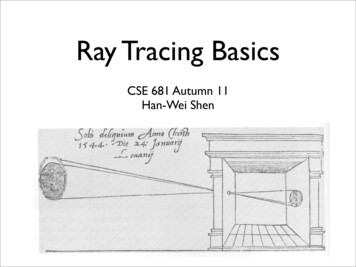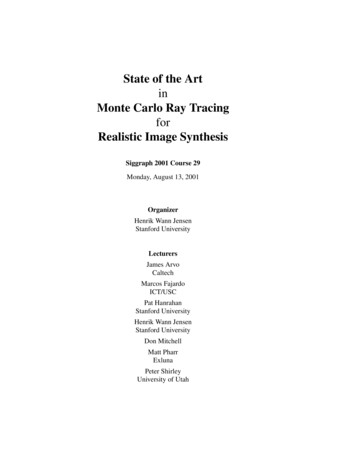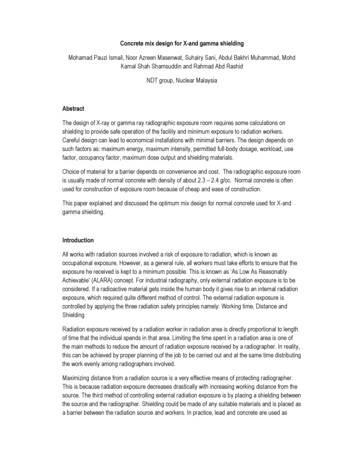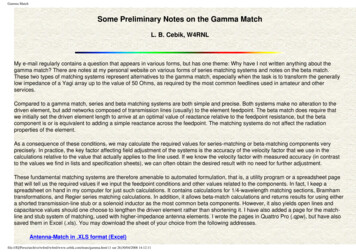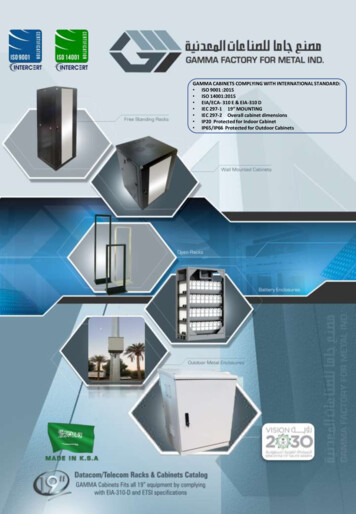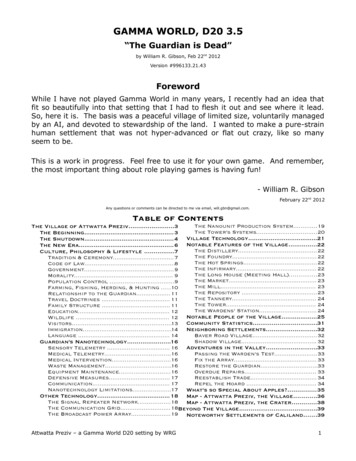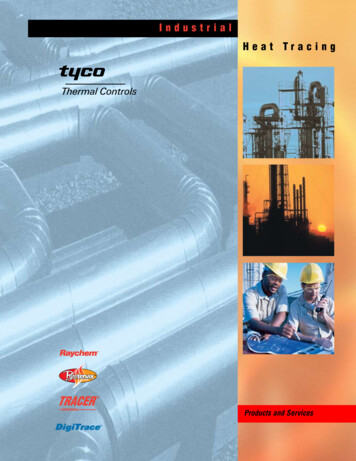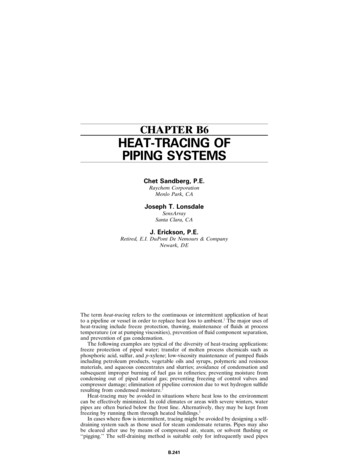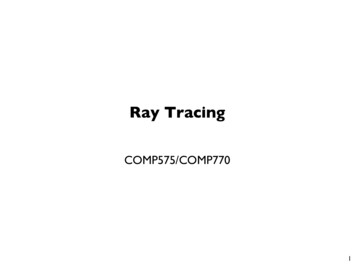
Transcription
Ray TracingCOMP575/COMP7701
Ray tracing idea 2
Ray Tracing: Example(from [Whitted80])
Ray Tracing: Example
Ray Tracing for Highly RealisticImagesVolkswagen Beetle with correct shadows and (multi-)reflections oncurved surfaces
Reasons for Using Ray Tracing Flexible Primitive TypesVolume visualization using multiple iso-surfaces
Ray tracing algorithmfor each pixel {compute viewing rayintersect ray with scenecompute illumination at visible pointput result into image}7
Generating eye rays Use window analogy directly8
Generating eye raysPERSPECTIVEORTHOGRAPHIC 9
Vector math review Vectors and points Vector operations– addition– scalar product More products– dot product– cross product Bases and orthogonality10
Generating eye rays—orthographic Just need to compute the view plane point s:– but where exactly is the view rectangle? 11
Generating eye rays—orthographic 12
Generating eye rays—perspective View rectangle needs to be away from viewpoint Distance is important: “focal length” of camera– still use camera frame but position view rect away fromviewpoint– ray origin always e– ray direction now controlled by s 13
Generating eye rays—perspective Compute s in the same way; just subtract dw– coordinates of s are (u, v, –d) 14
Pixel-to-image mapping One last detail: (u, v) coords of a pixeljj 2.5ii 3.5i –.5j –.515
Ray intersection 16
Ray: a half line Standard representation: point p and direction d––––this is a parametric equation for the linelets us directly generate the points on the lineif we restrict to t 0 then we have a raynote replacing d with ad doesnʼt change ray (a 0)17
Ray-sphere intersection: algebraic Condition 1: point is on ray Condition 2: point is on sphere– assume unit sphere; see Shirley or notes for general Substitute:– this is a quadratic equation in t18
Ray-sphere intersection: algebraic Solution for t by quadratic formula:– simpler form holds when d is a unit vector but we wonʼt assume this in practice (reason later)– Iʼll use the unit-vector form to make the geometric interpretation 19
Ray-sphere intersection: geometric 20
Ray-box intersection Could intersect with 6 faces individually Better way: box is the intersection of 3 slabs 21
Ray-slab intersection 2D example 3D is the same! 22
Intersecting intersections Each intersection is an interval Want last entry point and first exit pointShirley fig. 10.16 23
Ray-triangle intersection Condition 1: point is on ray Condition 2: point is on plane Condition 3: point is on the inside of all three edges First solve 1&2 (ray–plane intersection)– substitute and solve for t: 24
Ray-triangle intersection In plane, triangle is the intersection of 3 half spaces 25
Inside-edge test Need outside vs. inside Reduce to clockwise vs. counterclockwise– vector of edge to vector to x Use cross product to decide 26
Ray-triangle intersection 27
Ray-triangle intersection See book for a more efficient method based on linear systems– (donʼt need this for Ray 1 anyhow—but stash away for Ray 2) 28
Image so far With eye ray generation and sphere intersectionSurface s new Sphere((0.0, 0.0, 0.0), 1.0);for 0 iy nyfor 0 ix nx {ray camera.getRay(ix, iy);hitSurface, t s.intersect(ray, 0, inf)if hitSurface is not nullimage.set(ix, iy, white);} 29
Intersection against many shapesGroup.intersect (ray, tMin, tMax) {tBest inf; firstSurface null;for surface in surfaceList {hitSurface, t surface.intersect(ray, tMin, tBest);if hitSurface is not null {tBest t;firstSurface hitSurface;}}return hitSurface, tBest;} 30
Image so far With eye ray generation and scene intersectionfor 0 iy nyfor 0 ix nx {ray camera.getRay(ix, iy);c scene.trace(ray, 0, inf);image.set(ix, iy, c);} Scene.trace(ray, tMin, tMax) {surface, t surfs.intersect(ray, tMin, tMax);if (surface ! null) return surface.color();else return black;} 31
Shading Compute light reflected toward camera Inputs:– eye direction– light direction (for each of many lights)– surface normal– surface parameters (color, shininess, ) 32
Diffuse reflectionTop face of cube receives a certain amount of lightTop face of 60º rotated cube intercepts half the lightIn general, light per unit area is proportional to cos θ l n 33
Lambertian shadingillumination from sourcediffuse coefficientdiffusely reflected light 34
Lambertian shading[Foley et al.] Produces matte appearance 35
Diffuse shading36
Image so farScene.trace(Ray ray, tMin, tMax) {surface, t hit(ray, tMin, tMax);if surface is not null {point ray.evaluate(t);normal surface.getNormal(point);return surface.shade(ray, point,"normal, light);}else return backgroundColor;} Surface.shade(ray, point, normal, light) {v –normalize(ray.direction);l normalize(light.pos – point);// compute shading} 37
Shadows Surface is only illuminated if nothing blocks its view of the light. With ray tracing itʼs easy to check– just intersect a ray with the scene! 38
Image so farSurface.shade(ray, point, normal, light) {shadRay (point, light.pos – point);if (shadRay not blocked) {v –normalize(ray.direction);l normalize(light.pos – point);// compute shading}return black;} 39
Shadow rounding errors Donʼt fall victim to one of the classic blunders: Whatʼs going on?– hint: at what t does the shadow ray intersect the surface youʼre shading? 40
Shadow rounding errors Solution: shadow rays start a tiny distance from the surface Do this by moving the start point, or by limiting the t range 41
Multiple lights Important to fill in black shadows Just loop over lights, add contributions Ambient shading– black shadows are not really right– one solution: dim light at camera– alternative: add a constant “ambient” color to the shading 42
Image so farshade(ray, point, normal, lights) {result ambient;for light in lights {if (shadow ray not blocked) {result shading contribution;}}return result;} 43
Specular shading (Blinn-Phong) Intensity depends on view direction– bright near mirror configuration 44
Specular shading (Blinn-Phong) Close to mirrorhalf vector near normal– Measure “near” by dot product of unit vectors3specularly reflected lightspecular coefficient 45
Phong model—plots[Foley et al.] Increasing n narrows the lobe 46
[Foley et al.]Specular shading47
Diffuse Phong shading 48
Ambient shading Shading that does not depend on anything– add constant color to account for disregarded illuminationand fill in black shadowsambient coefficientreflected ambient light49
Putting it together Usually include ambient, diffuse, Phong in one model The final result is the sum over many lights 50
Mirror reflection Consider perfectly shiny surface– there isnʼt a highlight– instead thereʼs a reflection of other objects Can render this using recursive ray tracing– to find out mirror reflection color, ask what color is seenfrom surface point in reflection direction– already computing reflection direction for Phong “Glazed” material has mirror reflection and diffuse– where Lm is evaluated by tracing a new ray 51
Mirror reflection Intensity depends on view direction– reflects incident light from mirror direction352
Diffuse mirror reflection (glazed)(glazed material on floor) 53
Ray tracer architecture 101 You want a class called Ray– point and direction; evaluate(t)– possible: tMin, tMax Some things can be intersected with rays–––––individual surfacesgroups of surfaces (acceleration goes here)the whole scenemake these all subclasses of Surfacelimit the range of valid t values (e.g. shadow rays) Once you have the visible intersection, compute the color– may want to separate shading code from geometry– separate class: Material (each Surface holds a reference to one)– its job is to compute the color54
Architectural practicalities Return values– surface intersection tends to want to return multiple values t, surface or shader, normal vector, maybe surface point– in many programming languages (e.g. Java) this is a pain– typical solution: an intersection record a class with fields for all these things keep track of the intersection record for the closest intersection be careful of accidental aliasing (which is very easy if youʼre new to Java) Efficiency– what objects are created for every ray? try to find a place for themwhere you can reuse them.– Shadow rays can be cheaper (any intersection will do, donʼt needclosest)– but: “First Get it Right, Then Make it Fast”55
! ! 55! Architectural practicalities! Return values! – surface intersection tends to want to return multiple values! t, surface or shader, normal vector, maybe surface point! –
